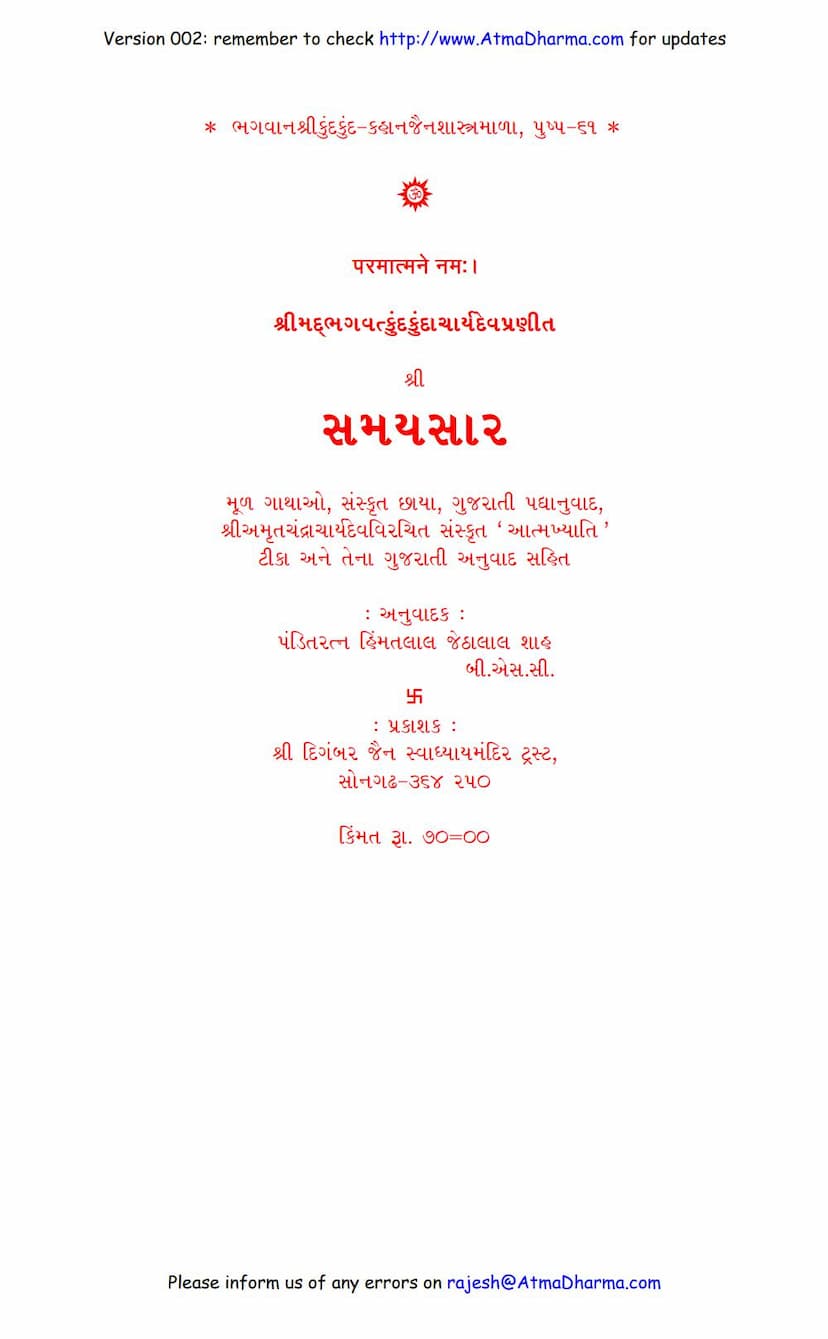Samaysara
Added to library: September 2, 2025

Summary
A comprehensive summary of the Jain text "Samaysara" by Kundkundacharya, with commentary by Amritchandracharya, translated by Himmatlal Jethalal Shah and published by Shri Digambar Jain Swadhyay Mandir Trust, Sonagadh:
Title: Samaysara (The Essence of Time/Reality) Author: Kundkundacharya Commentary: Amritchandracharya (Sanskrit: Atmakhyati) Translator (Gujarati): Pandit Ratna Himmatlal Jethalal Shah Publisher: Shri Digambar Jain Swadhyay Mandir Trust, Songadh
Overall Theme:
"Samaysara" is a foundational text in Jain philosophy, particularly within the Digambara tradition. Authored by the revered Acharya Kundkundacharya, it delves into the profound spiritual teachings of Jainism, focusing on the nature of the soul (Jiva) and its liberation from the cycle of birth and death (Samsara). The central theme is the realization of the soul's inherent pure, conscious, and blissful nature, distinct from all karmic bondage and worldly experiences.
Key Concepts and Structure:
The book is structured around the original Prakrit verses (Gathas) of Samaysara, accompanied by Amritchandracharya's profound Sanskrit commentary "Atmakhyati" and its Gujarati translation. The core of the text expounds upon the dual aspects of reality:
- Nischaya Naya (Ultimate Truth/Real Aspect): This perspective emphasizes the soul's inherent pure, unchanging, and self-luminous nature. It is the soul in its essential state, free from all karmic modifications. The goal is to realize this pure, singular consciousness.
- Vyavahara Naya (Conventional Truth/Practical Aspect): This perspective acknowledges the soul's empirical existence within the cycle of karma and Samsara. It describes the soul's interactions with other substances (non-soul) and the various states it undergoes due to karmic influx. Vyavahara Naya serves as a stepping stone to Nischaya Naya, guiding the aspirant through practices like meditation, devotion, and ethical conduct.
Summary of Key Chapters/Sections (as indicated by the Table of Contents):
The text is divided into several chapters, each exploring a crucial aspect of spiritual realization. While the provided text primarily contains the introductory and contextual material, the Table of Contents (pages 28-34) outlines the substantive chapters:
- Introduction/Preamble (Purvaranga): Sets the stage, introduces the author, the scripture's significance, and the lineage of Acharyas. It often includes auspicious invocations and philosophical context.
- Chapter 1: Jiva-Ajiva (Soul and Non-Soul): Differentiates between the soul (Jiva) – the sentient, conscious entity – and non-soul (Ajiva) substances like matter, space, time, and principles of motion and rest. It emphasizes the soul's inherent purity and freedom from these external categories.
- Chapter 2: Kartr-Karma (Agent and Action/Object): Explores the doctrine of karma and causality. It clarifies that the soul, in its pure state, is not the agent or experiencer of actions performed by non-soul entities (karma). The bondage and liberation are ultimately related to the soul's own consciousness and its perception of reality. It discusses how mistaken identification (mithyatva) leads to the soul being considered the doer and enjoyer of karmic actions.
- Chapter 3: Punya-Papa (Merit and Demerit): Analyzes the nature of merit (punya) and demerit (papa) karma. It explains that while these are conventional descriptions arising from the soul's interaction with karma, the ultimate truth (Nischaya Naya) transcends these dualities, as the soul's true nature is pure consciousness, untouched by karmic qualities.
- Chapter 4: Asrava (Inflow of Karma): Details the causes and nature of karmic influx into the soul. It identifies passions like anger, pride, deceit, greed, and ignorance (Kashayas and Mithyatva) as the primary drivers of karma's inflow.
- Chapter 5: Samvara (Cessation of Karma): Focuses on the methods to stop the influx of karma. This chapter highlights the importance of equanimity, mindfulness, right faith, knowledge, and conduct (Samyagdarshana, Samyagjnana, Samyagcharitra) as the means to achieve Samvara. It emphasizes the role of suppressing passions and external attachments.
- Chapter 6: Nirjara (Shedding of Karma): Explains the process of shedding existing karma. This involves practices like penance, meditation, self-purification, and the realization of the soul's true nature, which leads to the dissolution of karmic impurities.
- Chapter 7: Bandha (Bondage): Discusses the mechanism of karmic bondage and how it binds the soul to Samsara. It reiterates that the soul's mistaken identification with non-soul elements and its attachment to passions are the root causes of bondage.
- Chapter 8: Moksha (Liberation): This is the ultimate goal and the concluding chapter. It describes the state of liberation as the soul's realization of its pure, unalloyed, omniscient, and omnipotent nature, free from all karmic influence and the cycle of rebirth. This state is achieved through unwavering devotion to the true self, Right Faith, Right Knowledge, and Right Conduct (Nirvana).
Key Philosophical Tenets Highlighted:
- Anekantavada (Non-absolutism): The text reflects the Jain principle of manifold aspects of reality, where different viewpoints (Nayas) are valid from their own perspective but do not represent the ultimate truth in isolation.
- Soul as Pure Consciousness: The ultimate goal is to recognize the soul as pure, unchanging, sentient consciousness (Chaitanya) that is distinct from all physical and mental afflictions.
- Self-Reliance: Liberation is achieved through the soul's own efforts – through self-knowledge, self-experience, and self-purification, rather than external means or divine grace.
- Nischaya Naya (Ultimate Truth): The primary emphasis is on the absolute reality of the soul, which is ever-pure and detached.
- Vyavahara Naya (Conventional Truth): This is used as a means to understand the ultimate truth, guiding the practitioner through the practicalities of spiritual life.
Significance and Impact:
"Samaysara" is considered a pinnacle of Jain spiritual literature. Its profound insights into the soul's nature and the path to liberation have inspired countless spiritual seekers for centuries. The commentary by Acharya Amritchandra is highly esteemed for its clarity and depth, making the complex philosophical ideas of Kundkundacharya accessible. The translation and publication by Shri Digambar Jain Swadhyay Mandir Trust have further facilitated the study of this vital scripture.
This summary aims to provide a general overview based on the provided introductory pages and table of contents. The actual text of "Samaysara" contains elaborate philosophical discussions, analogies, and detailed explanations of Jain principles that are essential for a deeper understanding.